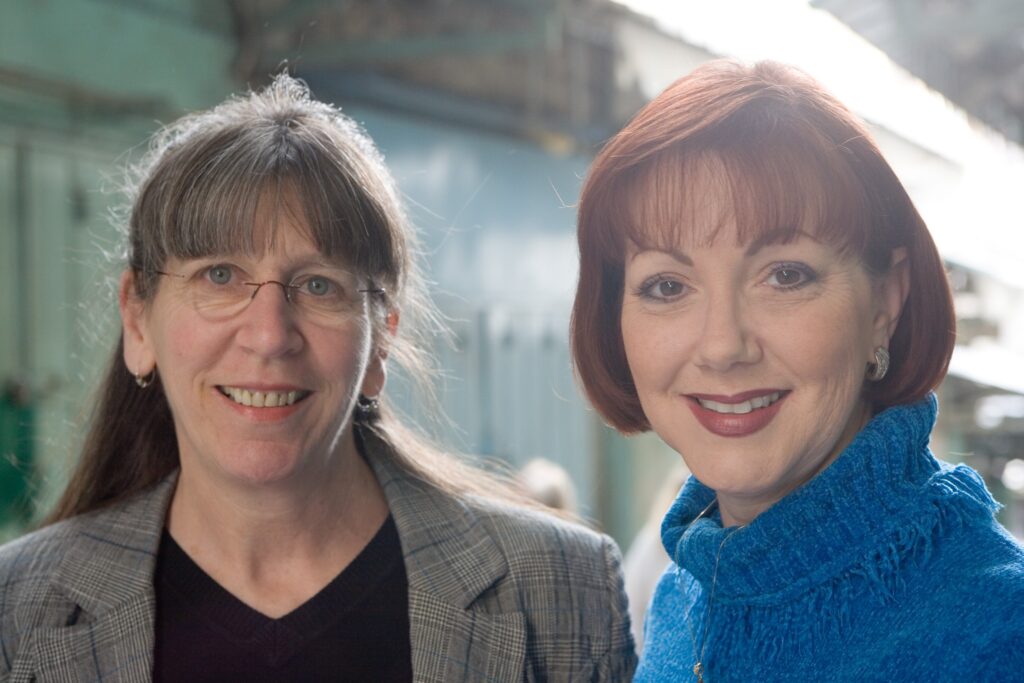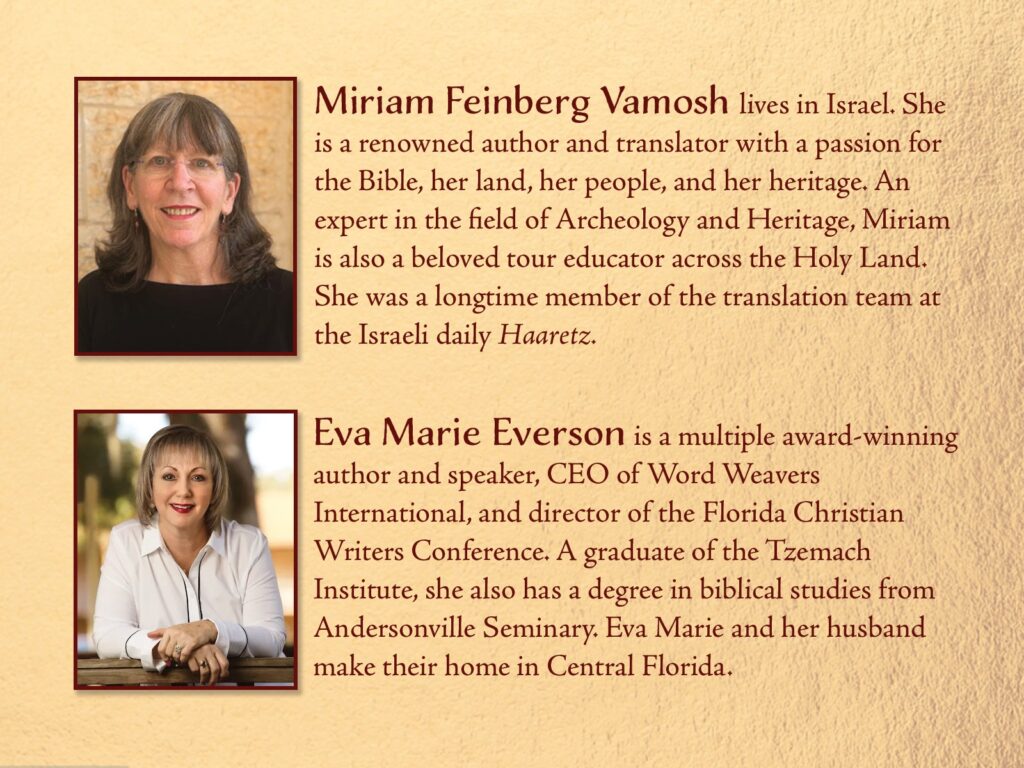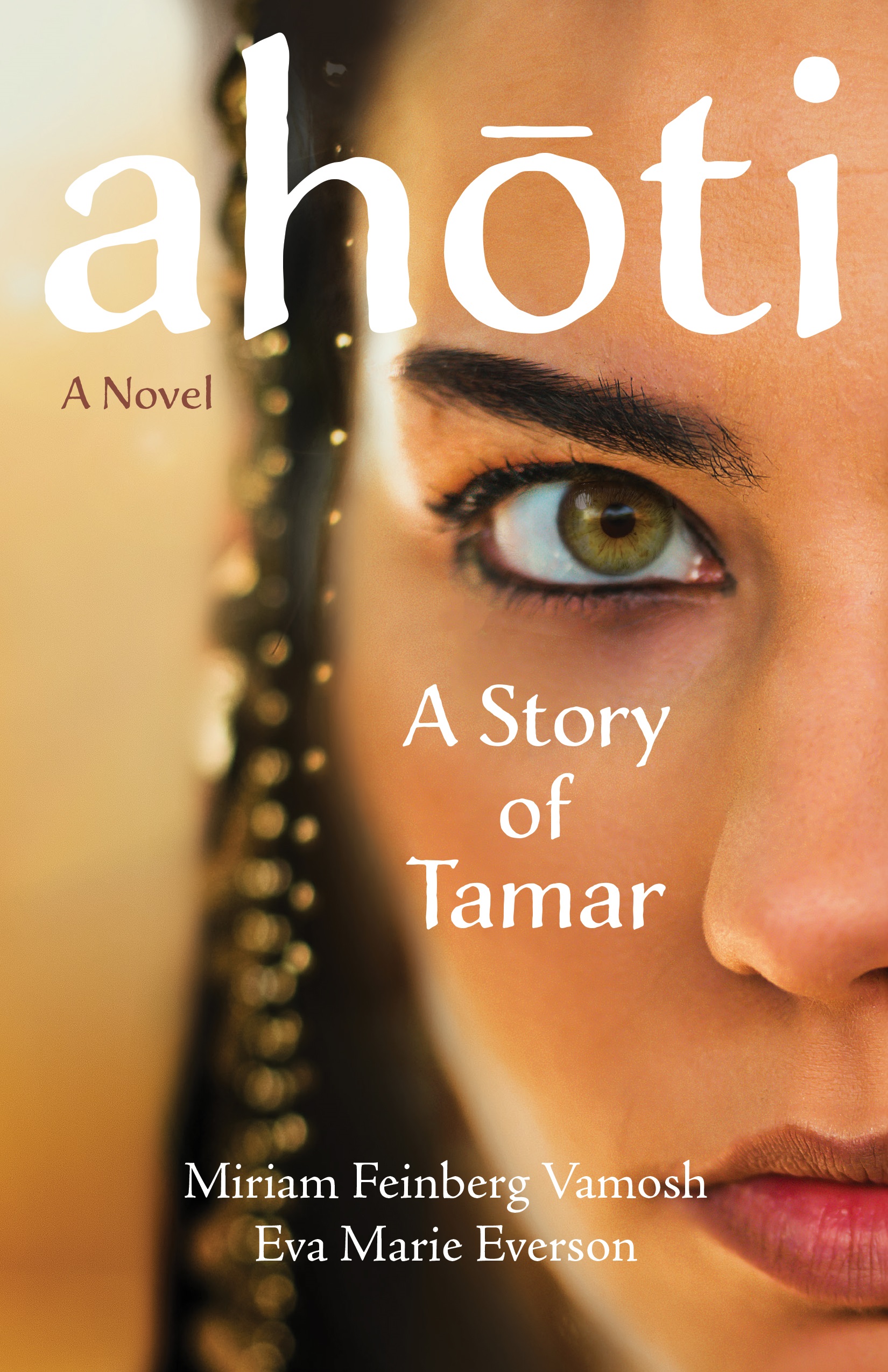Ahōti
I’m excited to feature, Ahōti: A Story of Tamar, by Eva Marie Everson and Miriam Feinburg Vamosh, in my blog this week. The novel is based on the tragic story of Tamar, daughter of King David. I’m looking forward to delving into this riveting story releasing May 14. At the end of this message, there’s a book-giveaway of Ahōti.
The story behind the book
1. How did the two of you meet?
Miriam: The first time I saw Eva Marie at Ben-Gurion Airport in June 2002. Eva Marie had arrived with a small group of women journalists who had been hand-picked to tour Israel with me with an itinerary based on my book, Women at the Time of the Bible, which I had written a few years before. Then, the Ministry of Tourism came up with the idea of a specialized tour of sites in the Holy Land where you could find the women of the Bible and focus on their story. It was such a privilege to put together what I had learned in writing Women at the Time of the Bible with an itinerary where I could actually show all the places where the female characters in the Bible were the “stars of the show.” And what a time we had…

Eva Marie: Like Miriam said, what a time that was! Of course, our “famous” story is that when a few of us went down (literally, one had to crawl down and then back up) to the newly discovered ancient palace of King Jabin (Joshua 11), I experienced a little “fall.” From that moment on, everything looked different to me . . . I experienced Israel from so many different levels.
At one point I said to Miriam, “We should write a book together!” We began to talk about what that would look like and, as God would have it, that book released in 2008 (Reflections of God’s Holy Land: A Personal Journey Through Israel, Thomas Nelson).
One of my favorite moments in Israel in ’02 was when we were in Beersheva. Miriam told us the story of Rebekah coming to be the bride of Isaac (Genesis 24). The English version of verse 64 that reads: Rebekah also looked up and saw Isaac. She got down from her camel.
BUT! Miriam explained . . . in the Hebrew text Rebekah doesn’t GET off her camel . . . she FALLS off her camel.
I replied to the group, “When was the last time your bridegroom made you fall off your camel?
2. What is the background of the “Ahoti” project? Tell us more about the ancient document that led to the writing of the book.
Miriam: My scientific adviser on the book I wrote about the daily life of children in the Bible was Prof. Meir Bar-Ilan, an expert on the subject. At the launch dinner for that book, I was to discover that he was an expert in another area – an ancient document called the Book of Gad the Seer. It’s actually mentioned in the Bible (1 Chron. 29:29) but was believed to have been lost, like the other books mentioned in that same verse. But as it turned out, it wasn’t lost. A copy of this book had been preserved by the ancient Jewish community of Cochin, India, whose elders said it had been brought to them by the Jews of Yemen, who had come to Yemen when they were exiled from their homeland by the Babylonians after the destruction of the First Temple. There it remained, unrecognized, until Western scholars first laid eyes on it in the 18th century. Eventually, when the Scottish theologian Claudius Buchanan, became head of the Anglican Church in India he traveled to Cochin, captivated by the idea that the Jewish community there might be descended from the original Twelve Tribes. He was shown the document, which he recognized for the treasure that it was, and took it with him to England in 1809. It’s there to this day, at Cambridge University. And that’s where Prof. Bar-Ilan began his research, in the 1980s, which culminated in the publication of his definitive book on the subject The Words of Gad the Seer in 2015, introducing to a wider audience the commentaries of the author on various Bible stories about the reign of David. It was at that launch dinner that Prof. Bar-Ilan leaned over and whispered to me: “I have a story that needs telling, and I think you’re the one to tell it.” It was the story of Tamar, David’s daughter, who was raped by her half-brother Amnon (2 Sam. 13) and later remained “a desolate woman in her brother Absalom’s house.” But “Gad the Seer” takes the story much further. And so, based on the words of this ancient author, I believe Eva Marie and I are the first to turn one of its ancient tales into a contemporary novel with a resonant message for men and women today.
3. As you researched the story, what stood out the most to you about Tamar?
Miriam: My research led me to contemporary scholars who saw Tamar not only as a victim of sexual violence, as if that were not enough, but the pawn in a grand palace intrigue, the likes of which we can only imagine from hints in Scripture but make perfect sense once these scholars tied it all together. So I’d say what struck me most about Tamar was the enormity of what she had to overcome. In addition to the sexual violence, she endured at the hands of her half-brother, her father’s inaction and her brother Absalom’s grand plot, which led to her having to flee the palace and everything she knew and loved. But overcome she did, and her story, as Eva Marie and I imagined, can be our story – the story of every woman who faced insurmountable odds on the way to vindication.
Eva Marie: The moment that struck me the hardest was when we got to the part of Absalom’s death at the hands of their uncle, Joab. The Scriptures tell us that he had raped his father’s concubines (2 Samuel 16) and that David, upon returning to the palace (after running from his own son), had declared that he would take care of them for life. I said to Miriam (and we included this in the book), “How is it that King David took care of his concubines, but not his daughter?”
4. Tell us more about the Wise Woman of Abel and how you worked her into the story.
Miriam: Eva Marie and I put Tamar on an actual journey through the Holy Land, from Jerusalem, through the hill country of Samaria, past the Sea of Galilee, to a city that bore the same name as her mother, Maacah, David’s wife, whom David had, as we imagined it, exiled from the palace when Tamar was almost too young to remember her. This city is called “Abel Beit [Beth] Maacah” in the Bible (2 Sam. 20). There, a “wise woman” lived who plays a major role in the story of the rebellion of one Sheba son of Bichri against David. According to the story, Sheba hid and Abel and David’s general Joab was sent to capture him. My idea was that the “wise woman of Abel” was none other than Tamar herself, who had reached the city and begun a new life there in disguise, until it would be safe to continue her journey – to her mother’s home in Geshur. And why not? We don’t know her identity, and as Eva Marie pointed out, Scripture shows that she recognized Joab right away. What we did with that part of the story I think might be one of the most dramatic parts.
5. Was there a moment in the story that took your breath away as you were writing?
Miriam: And that excellent question allows me to continue the previous answer. How we pictured Tamar, as the “wise woman of Abel” diffusing the situation with planning, wisdom, and yes, a good dose of shrewdness – all characteristics that the heroines of the Bible used to save themselves and often the lives of others.
Eva Marie: The end. But I won’t give it away!
6. What do you hope is the takeaway from Ahoti?
Miriam: After reading Ahoti, I hope readers realize that Tamar’s story of despair, though it happened thousands of years ago and thousands of miles away for most, is still the story of so many women today who are victims of sexual violence. To this day, despite all the advances society has made, we still have to find within ourselves every bit of fortitude and determination we can to survive and thrive. Her story is our story.
Eva Marie: While rape and abuse and even betrayal are part of too many women’s stories, it is only a small portion. We are women. We are strong (we have to be). So many see us as the “weaker sex,” but anyone who has ever lived as a woman knows that is just not true. We. Are. Strong. When I speak to women about the effects of rape, I reiterate: “You are not a victim. You are a victor. This is a moment in your life. It is not the moments of your life. Grab hold of what God has given and not what life has taken away.”
7. Can you tell us more about your families?
Miriam: What comes now is the short version, believe it or not: My Feinberg grandfather came from a village near Bialystok on the western edge of what was then the Russian Empire, arriving New York in 1901. My grandmother, Dora (nee Garfinkel) came over in 1893 from Novogrudok (Novardok). Today both of these towns are in Belarus. Both sides of my father’s Milton (Mordechai) Feinberg’s family (and see below, my mother’s family as well) emigrated to the United States to save their lives from anti-Semitic pogroms of the late nineteenth century. Think Fiddler on the Roof. My mother’s name was Danessa, a name her mother invented to commemorate her father, Daniel Bachrach, who died before she was born. My grandmother, Rachel Friedlob Bachrach, was born in Przasnysz, Poland, and came to the U.S. in 1886, when she was about 4 years old. My mother was born in Cincinnati, Ohio and my father was born in New York. Together with my older sister and brother, I was brought up in Trenton N. J., where my father was a Jewish community social worker, and my mother was a housewife and social activist. I moved to Israel as a teenager (another story for another time).
I have two daughters, Maya and Nili, who together with their lovely husbands, brought our five cherished grandchildren into the world.
I must add here a little about the family of my late husband Aaron (who was a wounded warrior of the 1973 Yom Kippur War, and who died on Israel Independence Day 2023). His mother, Tamar – yes, another connection – and his father Moshe, were from Hungary. After surviving the Holocaust, they came to Israel in 1949, made their home in Jerusalem and raised their two wonderful sons here. My eldest granddaughter Tamar, 13, was named for her grandmother and for Tamar of the Bible, both of whom exemplified strength, courage and will to survive.
Eva Marie: I was born and reared in a small Southern town (Sylvania, Georgia). Picture Mayberry. I had a wonderful life growing up. Not perfect, but good. One baby brother, mother, father, me. The quintessential family of the 1950s/1960s . . . going on into the 1970s.
I was raised in church and my whole life I loved God but in the early/early 1970s I came to Christ during The Jesus Movement.
I married my husband Dennis in 1979. With him came two wonderful children, then we brought Jessica into the family. All three are now married and we have nine grandchildren between us.
8. What’s next after Ahoti?
Miriam: When I wrote Prof. Bar-Ilan that the seed he planted of the story of Tamar in Gad the Seer had borne fruit, he was thrilled, and immediately emailed me back the next stories he wants us to tell!
Eva Marie: I’m excited to see what happens next with Miriam. Working with her is simply amazing. I do have another work of Southern fiction that I’m about to sign a contract for (Title: Beth Bettencourt). And, as soon as we’re done with all the promotion for this book, I’m gonna take a long nap!

I hope learning more about the story behind the story, that you’ll be as excited as I am about reading Ahoti: A Story of Tamar. You have the opportunity to win a copy. Leave a comment with your thoughts about what it must have been like for Tamar, living through this experience with her family. I’ll select a name at random from those who comment and send the lucky participant a copy of Ahoti.
The book releases May 14. You can order a copy from the links below.

Tamar must have walked in a shadow of shame for so long. Ahoti sounds like an excellent read!
Thank you, Priscilla. The most important thing for us to remember, I think, is that she was apparently very strong and smart (from what we read in the biblical text). If we take what we read from this ancient document and add it to what we know from the Bible, we have a powerful story . . . not of shame but of redemption! Oh, how I love God! He turns our mourning into dancing! 🙂 Praise Him! Praise Him!
Yes, Ahoti is well written and researched. So much so that I was pulled into the story and felt her pain and rejoiced in her perseverance and redemption.
Thank you, Priscilla.
This sounds like a great story I’d like to read.
Annie, I have admired your work and you for some time . . . I’d love to know you have read Ahoti! 🙂
Eva Marie
I hope you will, Annie, it’s an excellent book–pulls at the heart strings as we put ourselves into Tamar’s place.
I have enjoyed this book. What a fascinating story!
Thank you, Barbara!
I’m so glad, Barbara, I did, too!
I’m looking forward to reading this book. Thanks for sharing it with us.
I look forward to hearing what you think!
Eva Marie
I know you’ll enjoy it Candyce, and feel immersed into Tamar’s experience.
Sounds very interesting! Looking forward to reading this book and read more in depth what Tamar encountered growing up. I’m very fortunate and blessed that I grew up in a Christian home with Christian parents!!!!!!
Aren’t we though! 🙂
I look forward to hearing what you think, Martha!
Eva Marie
It’s hard for me to comprehend the challenges Tamar experienced. We are so blessed by the freedoms we have as women. Thank you for sharing, Martha.
I’m reading the book now and loving it. So interesting to get these glimpses into its birth and creation.
Oh, Terri! I’m so glad!
EME
I agree, Terri. The book pulled me right in and I’m grateful to Miriam and Eva Marie for sharing this additional information with us. Thank you for sharing your thoughts.
Fun learning more about these talented women.
Thank you Debbie! If you get the book you’ll have to let me know what you think!
Eva Marie
I agree, Debbie, we’re not often blessed with the story behind the book. I’m grateful Eva and Miriam shared with us.
Loved the interview. I got my copy earlier this week and can’t wait to read it. Thanks for sharing Katherine.
I’ve always been drawn to Tamar’s story and the abuse and injustice she experienced. I desire to read this book. Thanks for sharing, Katherine.
So enjoyed learning more backstory behind this exciting new book. Thank you for sharing Ms. Katherine.
You are welcome, sir. Hope you have a chance to read it. I learned so much about the history and culture of the region from this well-researched book. And the story pulled me in.